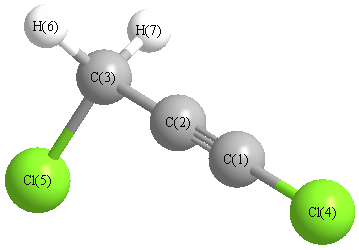Vibrational Frequencies calculated at TPSSh/aug-cc-pVDZ
| Mode Number |
Symmetry |
Frequency
(cm-1) |
Scaled Frequency
(cm-1) |
IR Intensities
(km mol-1) |
Raman Act
(Å4/u) |
Dep P |
Dep U |
|---|
| 1 |
A' |
3084 |
2983 |
8.83 |
|
|
|
| 2 |
A' |
2322 |
2246 |
103.52 |
|
|
|
| 3 |
A' |
1456 |
1408 |
1.71 |
|
|
|
| 4 |
A' |
1254 |
1213 |
57.60 |
|
|
|
| 5 |
A' |
1127 |
1090 |
0.45 |
|
|
|
| 6 |
A' |
676 |
654 |
91.11 |
|
|
|
| 7 |
A' |
621 |
600 |
25.97 |
|
|
|
| 8 |
A' |
371 |
359 |
2.07 |
|
|
|
| 9 |
A' |
263 |
254 |
0.92 |
|
|
|
| 10 |
A' |
80 |
77 |
1.23 |
|
|
|
| 11 |
A" |
3144 |
3041 |
0.17 |
|
|
|
| 12 |
A" |
1164 |
1126 |
0.26 |
|
|
|
| 13 |
A" |
897 |
868 |
0.09 |
|
|
|
| 14 |
A" |
270 |
261 |
0.10 |
|
|
|
| 15 |
A" |
171 |
166 |
7.26 |
|
|
|
Unscaled Zero Point Vibrational Energy (zpe) 8450.0 cm
-1
Scaled (by 0.9673) Zero Point Vibrational Energy (zpe) 8173.6 cm
-1
See section
III.C.1 List or set vibrational scaling factors
to change the scale factors used here.
See section
III.C.2
Calculate a vibrational scaling factor for a given set of molecules
to determine the least squares best scaling factor.
Charges, Dipole, Quadrupole and Polarizability
Charges from optimized geometry at TPSSh/aug-cc-pVDZ
Charges (e)
| Number |
Element |
Mulliken |
CHELPG |
AIM |
ESP |
| 1 |
C |
-0.458 |
|
|
|
| 2 |
C |
0.767 |
|
|
|
| 3 |
C |
-0.098 |
|
|
|
| 4 |
Cl |
-0.220 |
|
|
|
| 5 |
Cl |
-0.090 |
|
|
|
| 6 |
H |
0.049 |
|
|
|
| 7 |
H |
0.049 |
|
|
|
Electric dipole moments
Electric dipole components in Debye
(What's a Debye? See section
VII.A.3)
| |
x |
y |
z |
Total |
| |
0.754 |
1.598 |
0.000 |
1.767 |
| CHELPG |
|
|
|
|
| AIM |
|
|
|
|
| ESP |
|
|
|
|
Electric Quadrupole moment
Quadrupole components in D Å
Polarizabilities
Components of the polarizability tensor.
Units are
Å
3 (Angstrom cubed)
Change units.
| |
x |
y |
z |
| x |
15.559 |
-0.344 |
0.000 |
| y |
-0.344 |
7.874 |
0.000 |
| z |
0.000 |
0.000 |
6.704 |
<r2> (average value of r
2) Å
2
| <r2> |
306.981 |
| (<r2>)1/2 |
17.521 |
